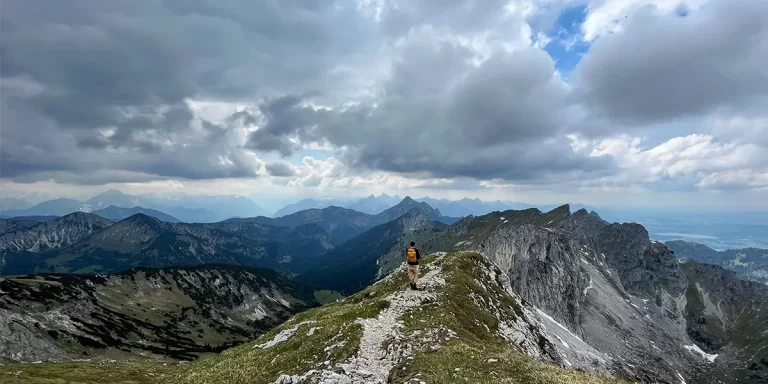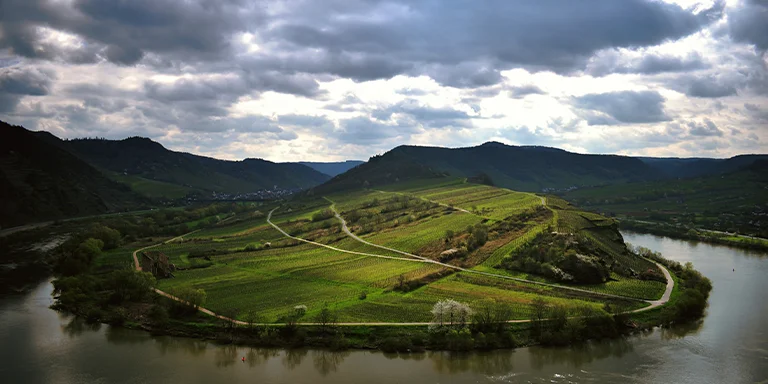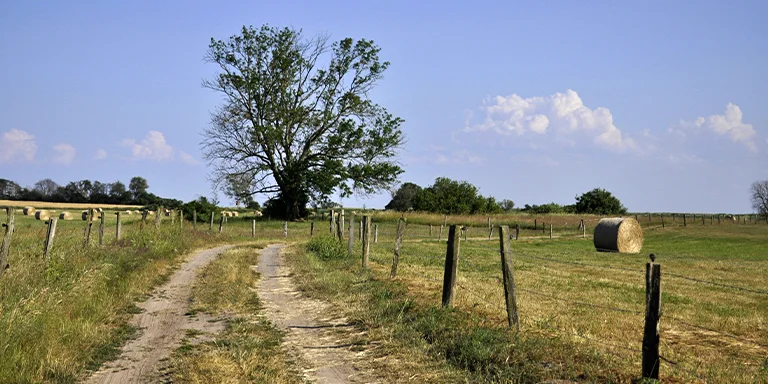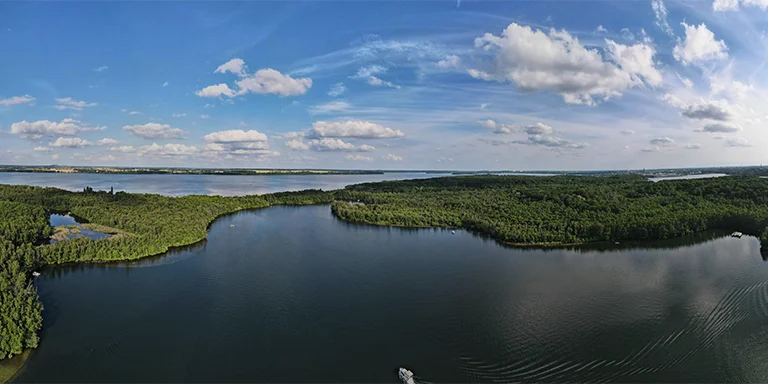

Backpacking in Germany offers immense variety for outdoor enthusiasts, from the rugged Bavarian Alps to the windswept Baltic coast, including popular destinations like the Black Forest National Park.
And that’s what this post is all about – backpacking in Germany. We’ll provide tips to help you prepare for backpacking in this diverse country as well as showcase the TOP 5 multi-day backpacking trails.
Interested? Let’s get started.
Explore Germany’s best scenic long trails for epic adventures:

Length: 105.5 mi / 169.8 km
Type: Point to point
Difficulty: Hard
Elevation Gain: 30 675 ft / 9350 m
Location: Oberstdorf
Estimated Hiking Calorie Burn: 28 500 calories
More Details: See on AllTrails
The 105-mile Oberstdorf to Meran trail is a challenging yet scenic 6-day Alpine crossing along the E5 route between Germany and Italy. Traversing meadows, forests, and mountain passes, the well-marked trail features breathtaking vistas of the Alps. Though a popular route, solitude can be found in the expansive alpine landscape. Overnight in the cozy mountain huts along the way and enjoy typical Bavarian fare. The changing mountain flora, historic huts, and diverse hikers encountered make this a special alpine trekking experience. Reserve hut spaces in advance for this coveted trail.

Length: 97.9 mi / 157.5 km
Type: Point to point
Difficulty: Hard
Elevation Gain: 18 369 ft / 5599 m
Location: Koblenz
Estimated Hiking Calorie Burn: 22 600 calories
More Details: See on AllTrails
This challenging 98-mile trail follows the Way of St. James from Koblenz to Trier in Germany’s Rhineland-Palatinate. Tracing the Moselle River and marked with yellow scallop shells, the scenic route has overnight options in charming riverside villages. Highlights include the Roman ruins in Trier, riverside castles, and palaces. The trail ends at the sarcophagus of St. Matthias in Trier Cathedral. Popular spring through fall, the trail provides a mix of nature, culture, and history. Be prepared for changing terrain while appreciating the beauty of the Moselle River Valley region.

Length: 35.7 mi / 60.2 km
Type: Out and back
Difficulty: Moderate
Elevation Gain: 2447 ft / 746 m
Location: Usedom Island Nature Park
Estimated Hiking Calorie Burn: 5600 calories
More Details: See on AllTrails
This scenic 37-mile out-and-back trail follows the coast from Zinnowitz to Swinoujscie on Germany’s Usedom Island in the Baltic Sea. Traversing maritime forests, beach promenades, and rugged shoreline, the moderately challenging route is best from September to October for bird migrations. Highlights include sandy beaches, swimming spots, seaside cafes, and coastal woodlands. Experience the maritime culture of western Pomerania as you encounter historic villages along the way. With camping options available, take time to enjoy nature and ocean vistas on this coastal trek on Usedom Island’s Ostseeweg trail.

Length: 38.2 mi / 61.5 km
Type: Loop
Difficulty: Hard
Elevation Gain: 3320 ft / 1012 m
Location: Schwerin
Estimated Hiking Calorie Burn: 5700 calories
More Details: See on AllTrails
This challenging 38-mile loop circles the lakes near Schwerin, Mecklenburg-Western Pomerania, Germany. The 4-day trail has beautiful views of glistening lakes, medieval towns, and fairytale castles. Highlights include Schwerin Castle, the bays of Schweriner Lake, Wiligrad Castle ruins, and abundant birdlife in serene nature reserves. Hike through enchanting forests and across meadows blooming with wildflowers. With plentiful villages along the route for overnight stays and meals, the trail can be hiked in either direction year-round. Experience the essence of this magical lake region on Germany’s captivating Schwerin Lake Loop.

Length: 106.8 mi / 171.9 km
Type: Point to point
Difficulty: Hard
Elevation Gain: 16 000 ft / 4877 m
Location: Franconian Forest Nature Park
Estimated Hiking Calorie Burn: 24 000 calories
More Details: See on AllTrails
The challenging 107-mile Rennsteig trail traverses the Thuringian Forest, following ridge lines through the Thuringian Slate Mountains and Franconian Forest in Germany. One of the most popular long-distance hiking routes in the country, the 8-day trek features unspoiled nature, panoramic views, and sites of historical significance. Passing tranquil villages and forest shelters along the way, highlights include the Kammweg, Werra River Valley overlooks, Inselberg, and the iconic Rennsteigwarte tower. Hiked for centuries, this Thuringia hiking gem provides a journey into culture and nature through little-explored rural Germany.
The weather for backpacking in Germany varies based on the season and region. In general:
Before selecting your equipment, examine the weather information for Germany (Munich).
| Jan | Feb | Mar | Apr | May | Jun | Jul | Aug | Sep | Oct | Nov | Dec | |
|---|---|---|---|---|---|---|---|---|---|---|---|---|
| High °F | 37 | 41 | 49 | 58 | 66 | 72 | 76 | 75 | 66 | 56 | 45 | 38 |
| Low °F | 26 | 26 | 32 | 38 | 46 | 52 | 56 | 55 | 47 | 40 | 33 | 28 |
| Rain/Snow (D*) | 10 | 9 | 11 | 9 | 12 | 12 | 13 | 11 | 11 | 10 | 10 | 12 |
Not sure if Germany is right for you?
Don’t forget to check out our backpacking guides for Austria and Poland.
When backpacking in Germany, planning is important when it comes to building campfires. You can only have fires in designated areas with grills or pre-built stone rings at campgrounds, not in forests or protected natural spots to avoid the risk of wildfires. Make sure to use only dead wood that has fallen away from trails and plants. Pay attention to any posted fire bans, especially during dry seasons. By being responsible, choosing approved sites, using the right materials, being careful in dry conditions, and fully putting out the fire, campers can still enjoy this traditional activity safely.
When you go hiking in Germany, make sure to plan your route ahead of time and let someone at home know your plans. Bring along a map, compass, and a GPS device. Dress appropriately for the changing mountain weather by wearing layers, waterproof gear, and proper footwear. It’s safer to hike with a companion, stick to marked trails, and be cautious of steep drop-offs. Check if permits are needed for certain alpine hiking areas. Be cautious of loose rocks, and remember that lightning can be a hazard in the mountains. Learn some basic German phrases in case you need to ask for help. Be ready for encounters with ticks, snakes, and insects by wearing long pants and checking yourself regularly.
Don’t get close to, feed, or try to attract animals on purpose. If you come across boars, don’t run because they might charge. Instead, move away slowly and give them room. Bears are uncommon, but it’s best not to engage with them if you see any. In wooded areas, be cautious of ticks and take off any that attach within 24 hours. When you see deer, foxes, or rabbits in forests, watch them from a distance without disturbing their homes. Birds, such as storks, often nest in fields, so respect the areas marked off with string.
U.S. citizens do not need a visa to visit Germany for tourism or business purposes for stays of up to 90 days within a 180 day period. To enter Germany without a visa, U.S. citizens need a valid passport. U.S. citizens can also apply for a residence permit after arrival if they plan to stay in Germany longer than 90 days.
When backpacking through Germany, pack a versatile layering system to adapt to the changeable mountain weather. Choose a lightweight, durable backpack under 40L to carry necessities like a sleeping bag, first aid kit, headlamp, and camping stove. Prepare for long distances on rugged trails by breaking in your hiking boots and training with weighted day hikes. Obtain topo maps and schedule overnights in mountain huts or campgrounds in advance. Traveling light will make steep Alpine hiking easier as you take in the stunning views, mountain culture, and fairytale castles along the way. A sense of adventure and sturdy boots are key to exploring Germany’s enchanting trails.
When planning a backpacking trip in Germany, be aware of potential hazards like rapidly changing mountain weather, steep and rocky trails, avalanche risks in the snow, and areas with unexploded ordnance from past wars. Obtain reliable maps, pack proper gear, share your route, and check conditions to avoid getting lost or injured in remote areas. On high Alpine routes, schedule overnight stays in mountain huts and carry cold weather and emergency gear. While generally safe, exercise caution around unrestrained dogs in rural areas. With sound preparation and caution, Germany offers incredible backpacking adventures and scenic routes to discover.